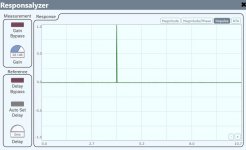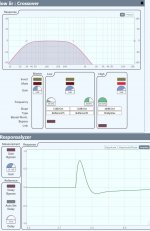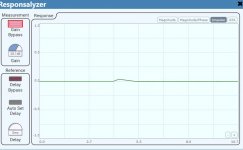Hi GM, i agree, for the reason I've given.
May i ask why you think so?
Greets!
As you say, H.E. is higher sensitivity, but SQ is pace, rhythm & timing [PRaT] and with higher sensitivity it just amplifies how good - bad the entire signal chain is.
GM
.. and until ever nearfield measurements reach the noise floor.Many people have measured drivers at different drive levels, the frequency response is always very similar until some sort of compression sets in.
Short tone bursts may be recorded at different levels, but I'm not hardworking enough for this
I guess I am focusing in on the deviation of Fr from 1watt to desired listening level...in a detailed way. Looking at the IR is more telling for me than looking at the FR
Please tell me how so....
Exactly what parts of the IR are telling you what ?
In my personal opinion, higher efficiency is desirable.
But as with all things, compromise.
The highest efficiency with smoothest frequency response, even though in many instances, this is opposite to reality, is the ultimate goal.
That's why I enjoy my ribbon tweeters so much. Breathtaking efficiency (95dB/1W) and very smooth frequency response, both in amplitude of output and impedance.
Getting the bass and midrange to match up to that performance, is the real challenge.
But as with all things, compromise.
The highest efficiency with smoothest frequency response, even though in many instances, this is opposite to reality, is the ultimate goal.
That's why I enjoy my ribbon tweeters so much. Breathtaking efficiency (95dB/1W) and very smooth frequency response, both in amplitude of output and impedance.
Getting the bass and midrange to match up to that performance, is the real challenge.
As soon as the transient starts leaning to the right like a shark fin...thats compression.
Compression of what frequencies?
And what makes it lean?
Is it compression alone, or timing changes too?
Last edited:
If every frequency is reduced equally, it will leave the shape of an impulse intact, but with a substantially lowered peak. So no lean.
If low freq only is what's compressed, you'll hardly see any change in impulse, other than a slight decrease in height. No lean again.
If high freq only is compressed, you can see a lean to the right like the shark fin you described.
Reason being, the high freq compression is essentially creating a low pass function.
Think through what constitutes a Dirac pulse and it should make more sense.
Looking solely at a woofer, yes you will see impulse lean because it lacks high freq. That simple...they all do.
But like i said in our other current exchange in the me464 thread,
why care about high freq response from a sub?
(past the point of handoff to low-mid)
If low freq only is what's compressed, you'll hardly see any change in impulse, other than a slight decrease in height. No lean again.
If high freq only is compressed, you can see a lean to the right like the shark fin you described.
Reason being, the high freq compression is essentially creating a low pass function.
Think through what constitutes a Dirac pulse and it should make more sense.
Looking solely at a woofer, yes you will see impulse lean because it lacks high freq. That simple...they all do.
But like i said in our other current exchange in the me464 thread,
why care about high freq response from a sub?
(past the point of handoff to low-mid)
I would think then its low frequency since thats where the excursion is...I don't know just know that its going to start leaning at some spl lol.
This thought isn't focus on one driver in particular, but the IR of a system as a whole...in order to make it make the most sense the IR would have to normalized....if the IR of a bass woofer is already leaning, then to apply my logic you would say that at some point in increasing SPL the IR will lean....more.
This thought isn't focus on one driver in particular, but the IR of a system as a whole...in order to make it make the most sense the IR would have to normalized....if the IR of a bass woofer is already leaning, then to apply my logic you would say that at some point in increasing SPL the IR will lean....more.
Last edited:
I'd advise again, to research / think through what makes a Dirac pulse, which is a perfect impulse, prefect mag and phase.
Every frequency contributes one sample, and one sample only, to a Dirac pulse.
What does the first sample of a 20Hz sine wave look like as the wave starts from t=0, heading to a peak amplitude 1/4 period later?
What is the amplitude of that first sample if all frequencies peaks have the same amplitude? next to nothing, huh.
What does the first sample of a 24Khz sine wave look like as the wave starts from t=0?
(Let's assume a 48kHz sampling freq, and Nyquist, the very highest frequency, is 24kHz)
What is the amplitude of that first sample, again if all the frequencies peaks have the same amplitude? Tippy top peak, huh.
So I hope you can see that the first sample, the first 0.02ms in time, has a pulse almost at zero amplitude from the 20Hz wave, and at full peak amplitude for the 24kHz wave.
That first sample, that 0.02ms is the entire time period of a Dirac pulse....and it is the sum of all frequencies' first sample.
So low freq's with low first sample amplitudes, contribute very little to the pulse height.
And high frequencies really dominate with their high first sample amplitudes.
Especially true for high frequencies since freq is on a linear basis.
(15-20k has as many summed contributions as 20Hz to 5kHz)
I've used understanding a perfect Dirac pulse to build outward to understand imperfect impulse....it's helped me alot...fwiw
Every frequency contributes one sample, and one sample only, to a Dirac pulse.
What does the first sample of a 20Hz sine wave look like as the wave starts from t=0, heading to a peak amplitude 1/4 period later?
What is the amplitude of that first sample if all frequencies peaks have the same amplitude? next to nothing, huh.
What does the first sample of a 24Khz sine wave look like as the wave starts from t=0?
(Let's assume a 48kHz sampling freq, and Nyquist, the very highest frequency, is 24kHz)
What is the amplitude of that first sample, again if all the frequencies peaks have the same amplitude? Tippy top peak, huh.
So I hope you can see that the first sample, the first 0.02ms in time, has a pulse almost at zero amplitude from the 20Hz wave, and at full peak amplitude for the 24kHz wave.
That first sample, that 0.02ms is the entire time period of a Dirac pulse....and it is the sum of all frequencies' first sample.
So low freq's with low first sample amplitudes, contribute very little to the pulse height.
And high frequencies really dominate with their high first sample amplitudes.
Especially true for high frequencies since freq is on a linear basis.
(15-20k has as many summed contributions as 20Hz to 5kHz)
I've used understanding a perfect Dirac pulse to build outward to understand imperfect impulse....it's helped me alot...fwiw
As soon as the transient starts leaning to the right
Got a screen shot?
The mechanical resistance is making them lean as the woofer reaches its limitations...
I'm not sure about timing but its likely that group delay is not static as well
At least with Altec and similar brands/models of [mid] bass woofers and now ancient 'FR' drivers, one can easily hear their output 'elongate' at high excursion, i.e. its timing and all associated with it isn't following the signal all the way up through the XO BW, but funny thing is that in modest amounts it's considered as a euphonic improvement over the recording as a replacement for low ['flea'] power high output impedance tube amp 'warmth'.
Don't recall ever seeing an impulse response of this, so wondering if this is the cause of 'leaning over'.
Thanks Mark and GM...I’ve got some learning to do.
I know for fact that an analog/digital compressor while lean the transients...so I just sssmed the same would be true for mechanical compression...in that case it’s not compression is limiting or clipping and we should correct the terminology
I know for fact that an analog/digital compressor while lean the transients...so I just sssmed the same would be true for mechanical compression...in that case it’s not compression is limiting or clipping and we should correct the terminology
Last edited:
I think high efficiency is a result of high motor strength (BL) compared to airload (Mms) and losses. Just like in any other motor application, the mechanical time constants are usually dominant. However, Re / Le still limit the current and its rate (respectively) with any change beginning to occur only after the application of voltage. Depending on all these, some sounds may take longer times to manifest compared to others. Linearity of BL and IM distortion may also have roles to play.
Personally, I feel that the key is to good SQ is decent linearity with limited bandwidth per driver (multi-way), linear phase and time alignment, enough efficiency to prevent thermal compression and a smooth response with minimal EQ.
Isn't quality (linearity assumed) just about which sounds are louder and which ones reach you first, with the first depending on EQ and the other on time alignment? A sealed box may sound good to many.
Personally, I feel that the key is to good SQ is decent linearity with limited bandwidth per driver (multi-way), linear phase and time alignment, enough efficiency to prevent thermal compression and a smooth response with minimal EQ.
Isn't quality (linearity assumed) just about which sounds are louder and which ones reach you first, with the first depending on EQ and the other on time alignment? A sealed box may sound good to many.
Last edited:
I would think then its low frequency since thats where the excursion is...I don't know just know that its going to start leaning at some spl lol.
This thought isn't focus on one driver in particular, but the IR of a system as a whole...in order to make it make the most sense the IR would have to normalized....if the IR of a bass woofer is already leaning, then to apply my logic you would say that at some point in increasing SPL the IR will lean....more.
Camplo, I am not certain, but I believe what you are referring to is 'wave steepening' which happens with a source that has high velocity. Close to the speaker, the wavefront looks like a gaussian curve, but farther away in distance and time it starts to look like a sawtooth form.
Got a screen shot?
I'm going to give a stab at what i think Camplo meant by sharc fin, and try to tie it to what i was saying about impulse pulses and Dirac.
First, here is a Dirac pulse, the impulse response of perfectly flat frequency response (mag) and perfectly flat phase at zero degrees.
(t=0 is set at 4sec to move it off origin to see it better)

Now here is a xover representing a somewhat typical sub, with 12dB low end rolloff at 30Hz, and a 12dB high end rolloff at 500Hz.
Note the impulse's 'sharc fin' look. (same t=0 at 4sec)
Also note the impulse was magnified upward with a +28 dB gain !!

Here's the same impulse with no gain added, taken at the same line level of the first Dirac impulse.
It shows how little the contribution of the bottom end is to a full range impulse response.

I so recommend full recognition that perfect mag and phase= perfect impulse response = Dirac pulse = perfect transient response = correct timbre / harmonics, etc, etc.
It also has helped me to visualize the timing implications of that perfection between frequencies.
By timing implications, i mean knowing what part of the frequencies waveforms are all in phase, peaks or starts? Once you see this, you've got it !.... ime
Perfect mag and phase, or perfect impulse, is the straight ruler all our measurements are based off.
Applying this ruler to each component of our speaker building process separately, drivers first, and then xovers, and finally summation, has really helped me untangle all the variables commonly juggled against each other.
....fwiw and hope this helped...
- Status
- This old topic is closed. If you want to reopen this topic, contact a moderator using the "Report Post" button.
- Home
- Loudspeakers
- Multi-Way
- Higher Sensitivity/Efficiency vs SQ